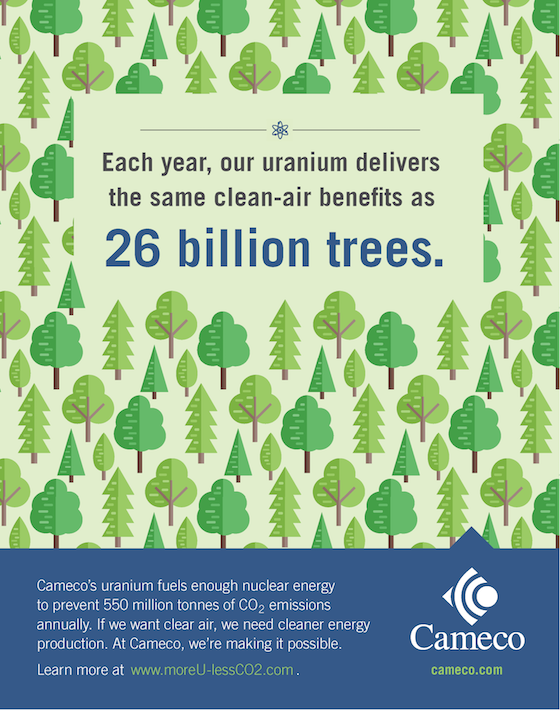Combatting Climate Change
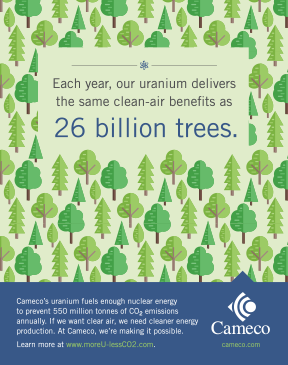
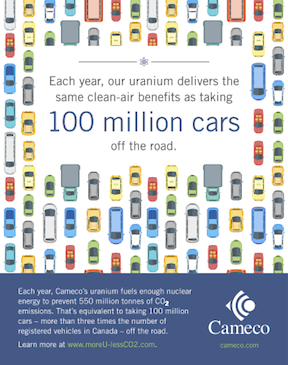
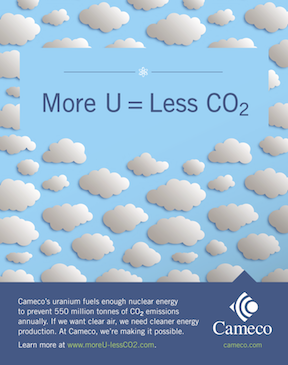
Nuclear power plants don't burn fossil fuels and, as a result, they do not generate carbon dioxide or contribute to air pollution. Cameco's uranium products displace the use of coal and natural gas, offering a clean source of baseload power.
But the same benefit as 26 billion trees? Or equivalent to taking 100 million cars off the road? REALLY?!
In fact, 22 tonnes of uranium used avoids the emission of one million tonnes of carbon dioxide, relative to coal. [source: WNA]
Considering Cameco's annual sales, that means our uranium fuels power plants that prevent the emission of 550.72 million tonnes of CO2 annually.
It would take 26 billion trees to sequester the same amount of carbon dioxide each year. [source: Arbor Environmental Alliance]
To have the same impact, we'd have to take over 100 million cars off the road. [source: US EPA]
The IEA forecasts that worldwide nuclear power currently offsets an estimated 2.5 billion tons of CO2 emissions yearly. [source: CNA ]
At Cameco, we're making it possible.
Clean energy
The biggest difference between fossil fuel and nuclear power generation plants is that nuclear plants don't burn anything or generate any greenhouse gas emissions. Nuclear power does not create acid rain, soot, urban smog or carbon dioxide emissions, the principal greenhouse gas.
In 2010 Cameco conducted a study of 20 government, academic and industry publications from around the world that examined GHG emissions. The report concluded:
- Greenhouse gas emissions of nuclear power plants are among the lowest of any electricity generation method and on a lifecycle basis are comparable to wind, hydro-electricity and biomass.
- Lifecycle emissions of natural gas generation are 15 times greater than nuclear.
- Lifecycle emissions of coal generation are 30 times greater than nuclear.
Nuclear power plants don't burn fossil fuels and, as a result, they do not contribute to air pollution. Emissions of carbon dioxide from burning fossil fuels are about 28 billion tonnes a year worldwide, of which around 38% comes from coal, 21% from gas and 41% from oil. Nuclear-generated electricity diverts about 2 billion tonnes of carbon dioxide from being released into the atmosphere every year.
Managed Waste
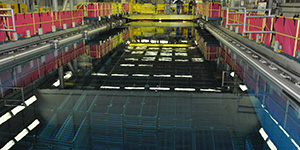
All industrial processes produce waste materials. Nuclear is no different. However, the management of nuclear waste products is markedly different.
The combustion of coal concentrates natural trace amounts of heavy metals including uranium and thorium, arsenic, cadmium, lead and mercury, sulphur dioxide contained within the coal. These trace elements become more concentrated in coal's waste product, fly ash, which represents about 10% of the original coal's volume. In the US, this equates into approximately 61 million metric tonnes of fly ash waste every year.
The use of natural gas also releases small amounts of radioactive radon. Though small, these amounts are often greater than from nuclear power generation.
Nuclear power stations, on the other hand, contain their waste in the spent fuel, and none is released into the environment. See Spent Fuel Management for more information.



